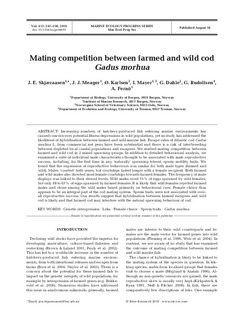| dc.contributor.author | Skjæraasen, Jon Egil | |
| dc.contributor.author | Meager, Justin J. | |
| dc.contributor.author | Karlsen, Ørjan | |
| dc.contributor.author | Mayer, Ian | |
| dc.contributor.author | Dahle, Geir | |
| dc.contributor.author | Rudolfsen, Geir | |
| dc.contributor.author | Fernö, Anders | |
| dc.date.accessioned | 2011-11-24T13:40:46Z | |
| dc.date.issued | 2010-08-18 | |
| dc.identifier.issn | 0171-8630 | |
| dc.identifier.issn | 1616-1599 | |
| dc.identifier.uri | http://hdl.handle.net/11250/108774 | |
| dc.description.abstract | Increasing numbers of hatchery-produced fish entering marine environments has caused concern over potential fitness depressions in wild populations, yet no study has addressed the likelihood of hybridisation between farmed and wild marine fish. Escape rates of Atlantic cod Gadus morhua L. from commercial net pens have been substantial and there is a risk of interbreeding between depleted local coastal populations and escapees. We studied mating competition between farmed and wild cod in 2 mixed spawning groups. In addition to detailed behavioural analysis, we examined a suite of individual male characteristics thought to be associated with male reproductive success, including, for the first time in any ‘naturally’ spawning teleost, sperm motility traits. We found that the expression of reproductive behaviours was similar for both male types (farmed and wild). Males ‘courted’ both sexes, but courtships lasted longer with a female recipient. Both farmed and wild males also directed most female courtships towards farmed females. The frequency of male displays was linked to their steroid levels. Wild males sired 75% of eggs spawned by wild females, but only 48 to 67% of eggs spawned by farmed females. It is likely that wild females rejected farmed males and chose among the wild males based primarily on behavioural cues. Female choice thus appears to be an integral part of the cod mating system. Sperm traits were not associated with overall reproductive success. Our results suggest that hybridisation between farmed escapees and wild cod is likely and that farmed cod may interfere with the natural spawning behaviour of cod. | no_NO |
| dc.language.iso | eng | no_NO |
| dc.publisher | Inter-Research | no_NO |
| dc.subject | cod | no_NO |
| dc.subject | torsk | no_NO |
| dc.subject | farmed fish escape | no_NO |
| dc.subject | fiskerømning | no_NO |
| dc.title | Mating competition between farmed and wild cod Gadus morhua | no_NO |
| dc.type | Journal article | no_NO |
| dc.type | Peer reviewed | no_NO |
| dc.subject.nsi | VDP::Agriculture and fishery disciplines: 900::Fisheries science: 920::Aquaculture: 922 | no_NO |
| dc.description.embargo | 2015-08-18 | |
| dc.source.pagenumber | 247-258 | no_NO |
| dc.source.volume | 412 | no_NO |
| dc.source.journal | Marine Ecology Progress Series | no_NO |
| dc.identifier.doi | http://dx.doi.org/10.3354/meps08670 | |
